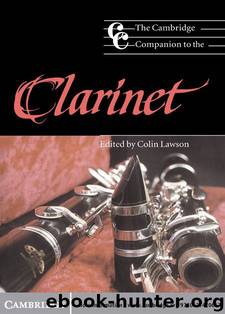The Cambridge Companion to the Clarinet (Cambridge Companions to Music) by Colin Lawson

Author:Colin Lawson [Lawson, Colin]
Language: eng
Format: epub
ISBN: 9780521470667
Publisher: Cambridge University Press
Published: 1995-12-14T02:00:00+00:00
7 Teaching the clarinet
PAUL HARRIS
Introduction
Today’s young musician is growing up in a social and musical world considerably different from even the recent past. The methods and theories of such music educators as Carl Orff, R. Murray Schafer, John Paynter and Keith Swanwick have become widely known and assimilated (if, perhaps, unconsciously) and the more recent emergence of examinations which engage the student in original composition (as well as performing and ‘listening’) has produced a new generation of young musicians more creative in their thought, more emotionally mature and more vividly aware of their surroundings – they are, to use the contemporary term, more ‘street-wise’. Our pupils are no longer to be seen as receptacles into which we ‘drop’ information – and thus we must acknowledge that the role of the teacher ‘is transformed from that of musical “director” to that of pupil facilitator: stimulating, questioning, advising and helping, rather than showing or telling’.1 We live in times of change and development, fin-du-siècle is a period of rethinking and innovation. It is in this spirit that we consider the various facets of clarinet teaching in the following pages.
The teacher
As instrumental teachers we are concerned with two distinct but interrelated disciplines. On the one hand, we must teach our pupils the skills necessary to play their instruments to the best of their abilities, and on the other, we must help them to develop their sense of artistry and musicianship. Drawing from students that subtle ability to communicate something of their innermost self through the medium of musical performance is simultaneously a most demanding and stimulating challenge. Without musical ‘personality’ performances will remain uninspired and the central message which music communicates is lost.
Learning to play a musical instrument and to perform music at all levels is both exacting and complex, requiring an approach that is methodical, imaginative, inspired, demanding, patient and sensitive. Such are the necessary prerequisites of the teacher. Rarely might you find all these attributes in one person, but a simple awareness of them is more than sufficient as a point of departure.
The lesson
The lesson constitutes the main, and often the only, point of contact with the pupil. Much care, thought and planning must therefore go into both its content and presentation. Ideally our pupils should leave their lessons feeling positive about themselves, about what they have achieved and about what they are to practise. This will arise from an approach that is challenging, absorbing, rewarding and stimulating. Anyone entering the teaching profession believing it to be an easy or second-rate option would be well advised to consider a different career! How then does one set about cultivating the ideal lesson?
The three principles: expectation – guidance – motivation
The key to presenting a successful lesson and indeed to cultivating a responsive and hard-working pupil is finding the appropriate balance between expectation, guidance and motivation, whilst all the time understanding the overriding necessity for communication. This balance will inevitably be different for every pupil; there is little doubt that the teacher who is sensitive to this can reasonably expect their pupils to try and give of their best.
Download
This site does not store any files on its server. We only index and link to content provided by other sites. Please contact the content providers to delete copyright contents if any and email us, we'll remove relevant links or contents immediately.
The Goal (Off-Campus #4) by Elle Kennedy(12477)
Kathy Andrews Collection by Kathy Andrews(10581)
Diary of a Player by Brad Paisley(6875)
What Does This Button Do? by Bruce Dickinson(5545)
Assassin’s Fate by Robin Hobb(5270)
Big Little Lies by Liane Moriarty(4903)
Pale Blue Dot by Carl Sagan(4031)
Sticky Fingers by Joe Hagan(3464)
The Heroin Diaries by Nikki Sixx(2948)
The Death of the Heart by Elizabeth Bowen(2920)
Beneath These Shadows by Meghan March(2735)
The Help by Kathryn Stockett(2713)
Confessions of a Video Vixen by Karrine Steffans(2690)
How Music Works by David Byrne(2554)
Jam by Jam (epub)(2506)
Harry Potter 4 - Harry Potter and The Goblet of Fire by J.K.Rowling(2426)
Strange Fascination: David Bowie: The Definitive Story by David Buckley(2377)
Petty: The Biography by Warren Zanes(2245)
Darker Than the Deepest Sea by Trevor Dann(2222)
